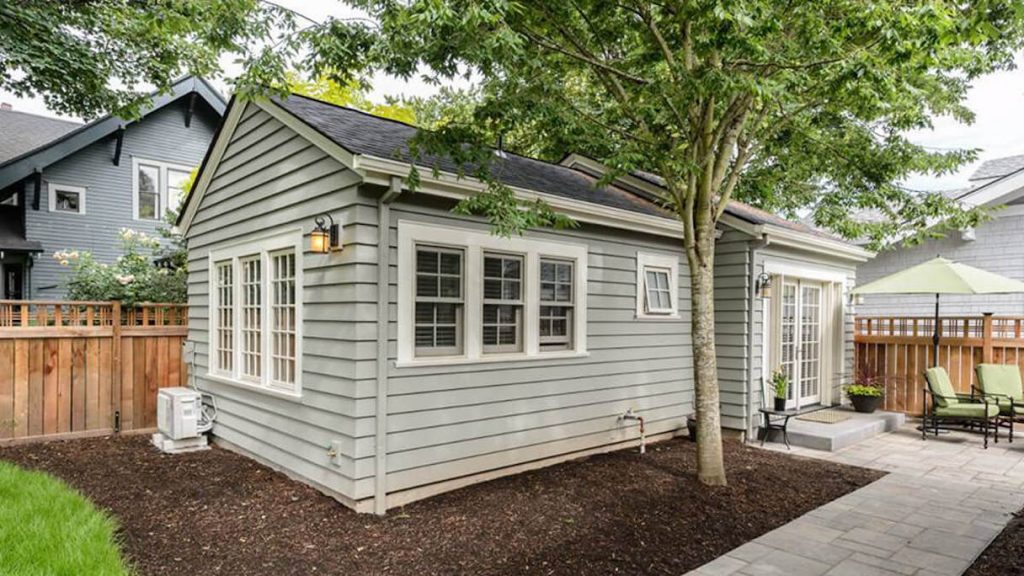
photo by accessorydwellings.org
By Richard Eisenberg | Money & Work Editor | Next Avenue
When Americans are surveyed about where they want to live as they get older, most say they’d like to stay in their homes and “age in place.” But many can’t, because their homes have too many stairs or are in frigid climates that aren’t hospitable. That’s why accessory dwelling units, or ADUs, are catching on.
And it’s why, if you own a home and have an aging parent, you may want to consider the possibility of your mother or father moving into one. Then, one day, if the ADU is vacant, you could find a tenant to move in and provide you with supplemental retirement income.
What Is an ADU?
An ADU — sometimes dubbed the unfortunate term “granny flat” — is typically a small, standalone structure with its own bathroom, sleeping quarters and kitchen, placed in a homeowner’s backyard.
In a recent AARP survey of adults 50 and older, 31 percent said they’d be willing to consider building one, perhaps to help them provide caregiving to their parent there.
“I was surprised the numbers were so high,” says Danielle Arigoni, director of livable communities at AARP.
Accessory Dwelling Units Are Spreading
Increasingly, cities and towns are updating their zoning rules to permit the construction of ADUs, especially in places where housing costs are high.
Los Angeles officials have encouraged homeowners to construct ADUs and since 2017, when new state laws went into effect, Los Angeles has seen more than a 1,000 percent increase in permit requests for ADU construction. Austin, Boston, Chicago, Denver, Portland, Ore., Seattle and Washington, D.C. are updating their housing codes for ADUs, too, says Eli Spevak, a Portland, Ore. developer (Orange Splot) who co-founded the Accessorydwellings.org site.
Arigoni says California and Oregon have seen a surge in ADUs “because the housing crisis there has been so dramatic.”
The Limitations of ADUs
But accessory dwelling units have a few limitations that have prevented them from becoming mainstream.
For instance, even when ADUs are legal locally, “other barriers exist,” says Arigoni. Certain communities consider them eyesores, making construction difficult.
“Sometimes, there are concerns on the impact it will have on the neighborhood,” says Spevak. “It’s pretty common for cities to allow ADUs in some form, but sometimes the rules are really strict.”
Another obstacle: although ADUs are generally small — often about 800 square feet — they’re rarely inexpensive.
Spevak says many cost $150,000 or more. “That’s a big chunk of money,” he notes.
Partly, the cost is due to conforming to local building codes and paying for utility hookups and construction. Also, some people ask builders to create fancy and pricey ADUs.
Also, most lenders don’t offer mortgages for ADUs. So buyers tend to pay with cash or with their home equity lines of credit, which restricts their availability.
How to Get an Accessory Dwelling Unit Built
If you’re contemplating having an ADU built for your parent, check with your town’s planning or building department for its rules. You may be able to find the rules online. Some places, like Berkeley, Calif. and Portland, Ore. offer ADU tours so you can look inside some.
Assuming you learn that an ADU is possible, look online for local builders with a history of constructing them. Then interview several to see if they can build the kind of place you have in mind and what it’ll cost.
Expect the ADU construction process to take six to eight months.
“It’s a big endeavor to take on,” says Kol Peterson, a co-founder of accessorydwellings.org who lives in an ADU. “If you want to get one built, don’t wait until it’s time. People often spend a lot of time on design work and then find the city requires an additional parking space or the homeowners association they live in doesn’t allow it.”
Arigoni is optimistic about the future for ADUs. Without undertaking massive construction of apartment buildings, “this is a way to change the fabric of a community that can be very compatible with the features of the existing neighborhood,” she says.
![]() This article originally appeared on Next Avenue
This article originally appeared on Next Avenue
© Twin Cities Public Television - 2019. All rights reserved.
Read Next



